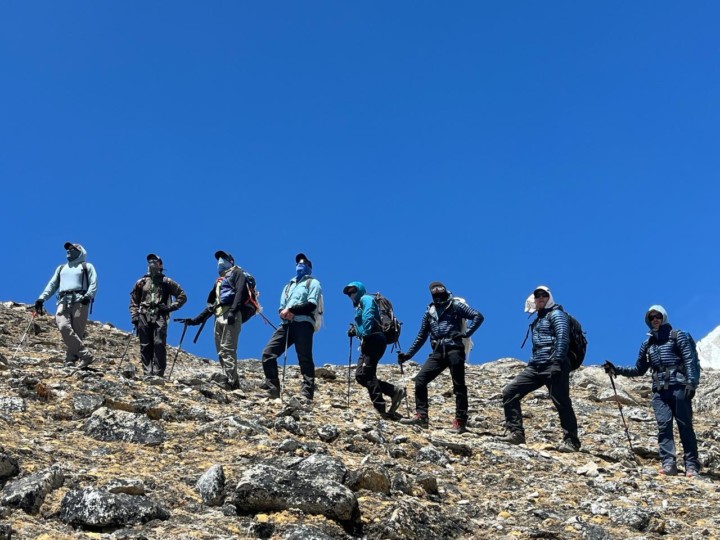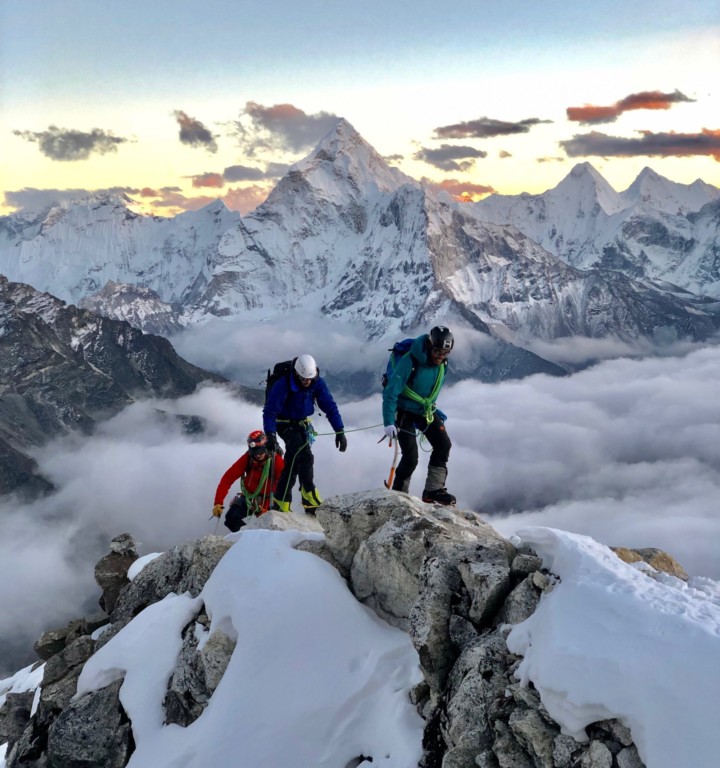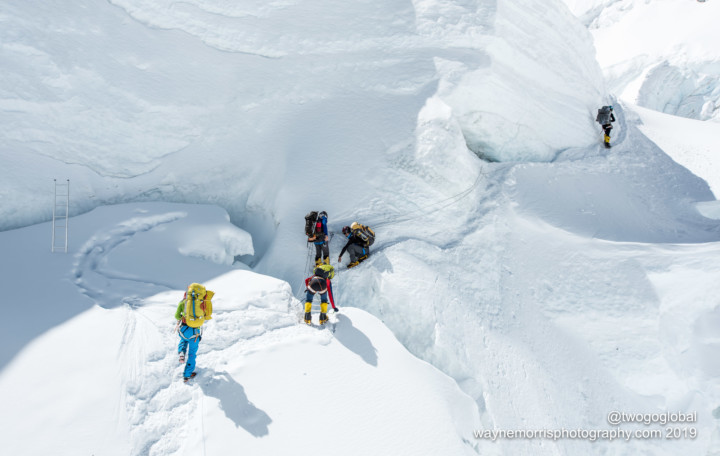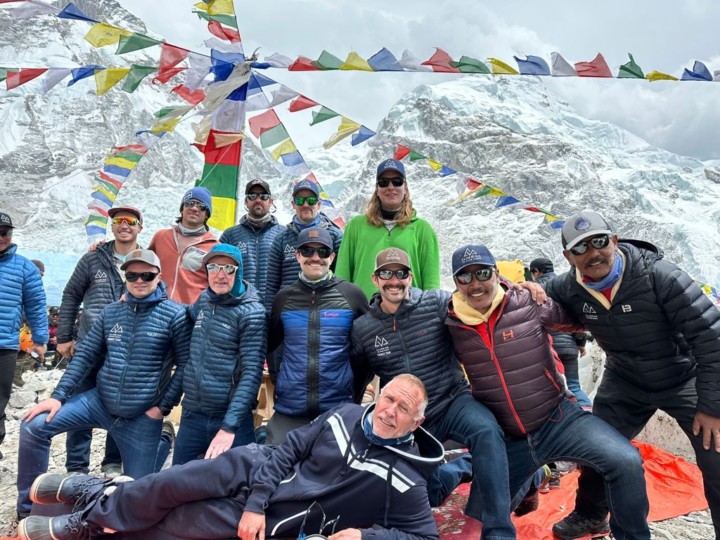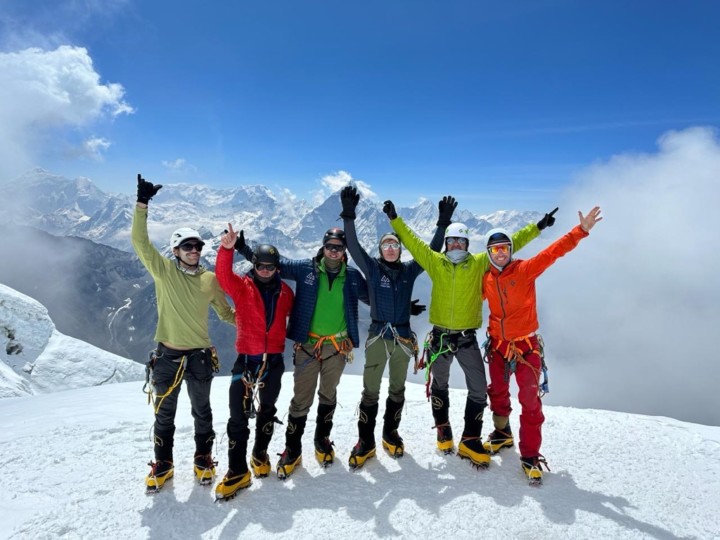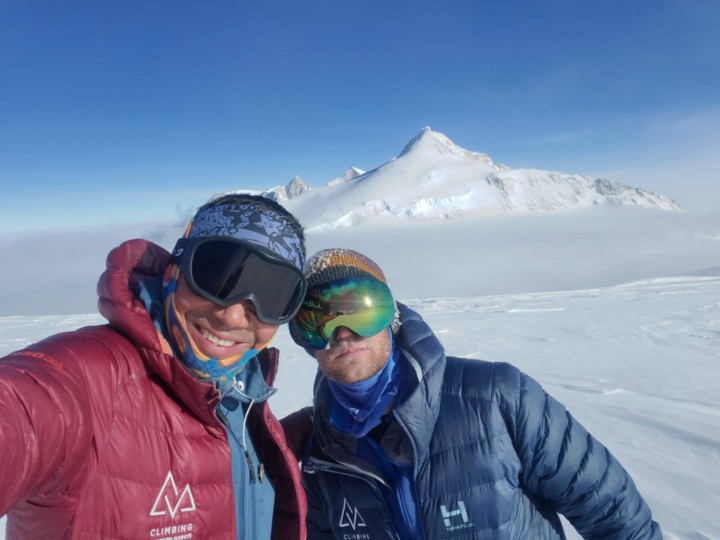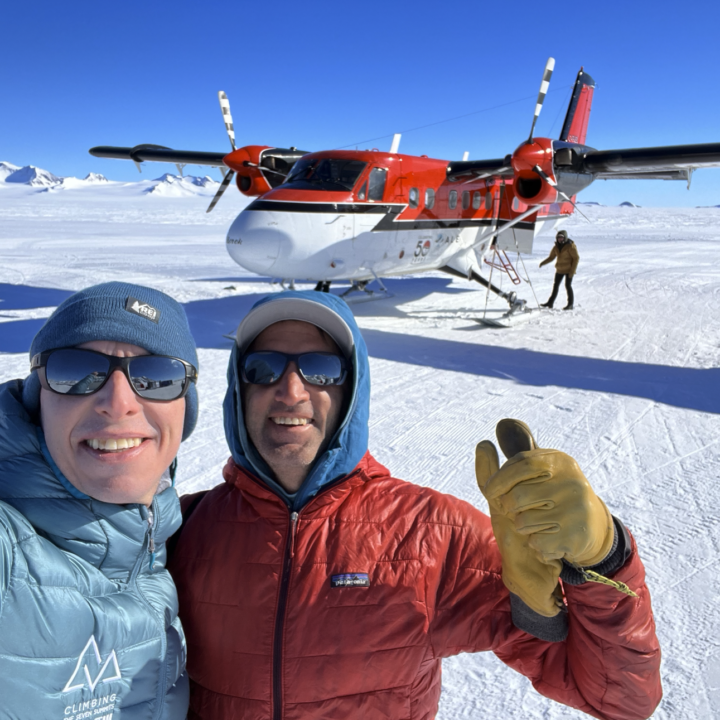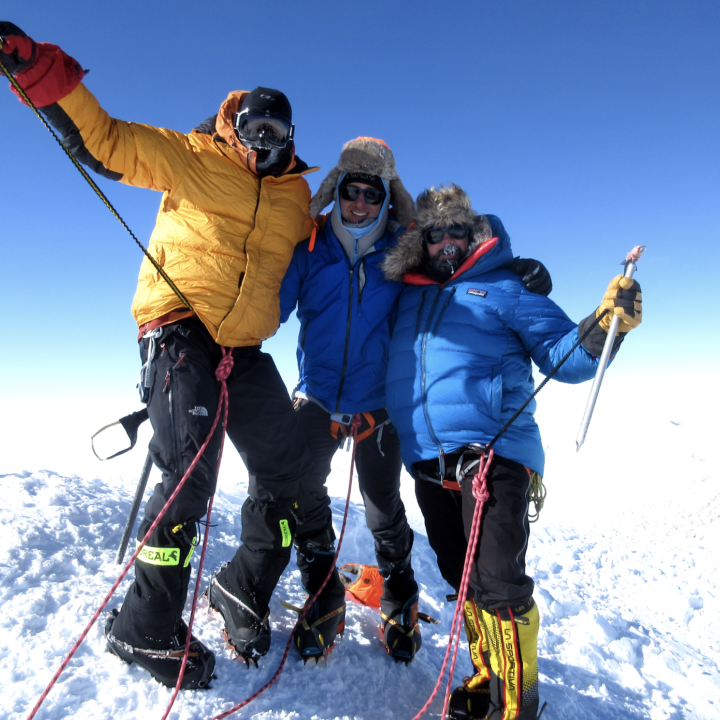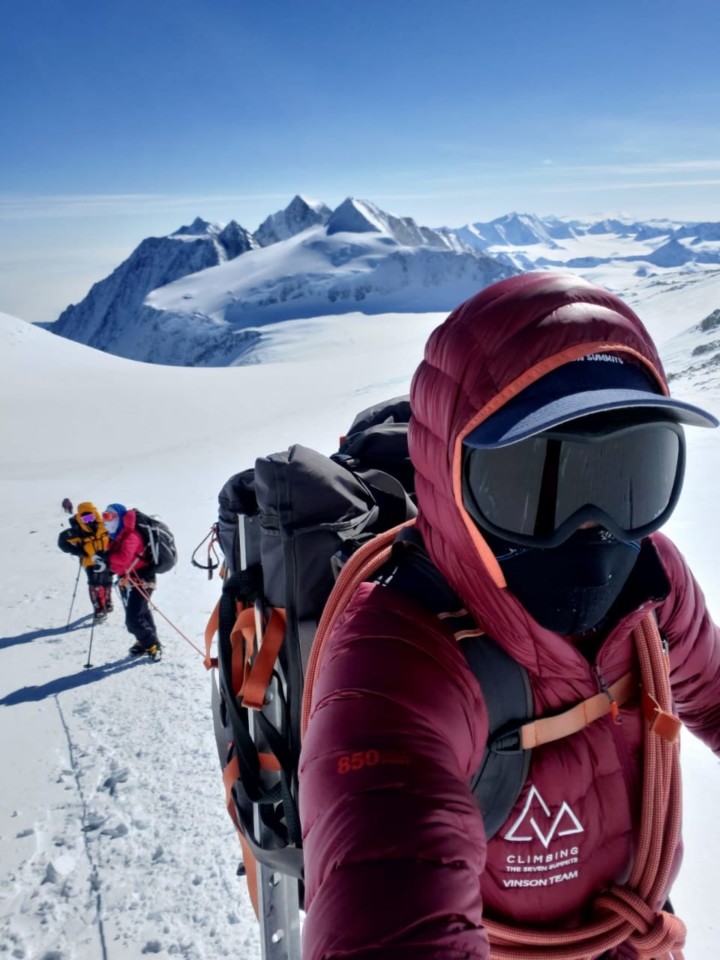Farewells and Arrivals in the Himalayas
April 20th
We hope you are enjoying your weekend. Here are some updates from our teams in the Himalaya.
Our Everest Base Camp team flew by helicopter back to Kathmandu and are all safely checked into the Hyatt, enjoying hot showers and the creature comforts of town. What a great group of adventurers. We'll be sad to wave farewell to such a great group as they head home in coming days but congratulate them on their incredible success and strength.
Our Gokyo trekkers reached Gokyo yesterday and explored the region today. Seeing the Lakes and Peaks in this spectacular region. They will begin their downtrek tomorrow.
Our 3 Peaks team have summited Island Peak (19th April) and in doing so rounded out an incredible 3 mountains in under 3 weeks. In a low snowfall season, the routes have been more technical and challenging and we are so impressed by all they have achieved. A special shout out to both Monika Z & Faris R who pulled off 3/3! Today they moved from Chukkung to Pangboche and tomorrow they will drop further down to Namche. We looking forward to seeing them in KTM in coming days.
Our Lobuche team did a big day with an 8.5hour down trek from Pheriche to Namche today. Tomorrow is their last day on the trail back to Lukla where they will fly back to Kathmandu to celebrate.

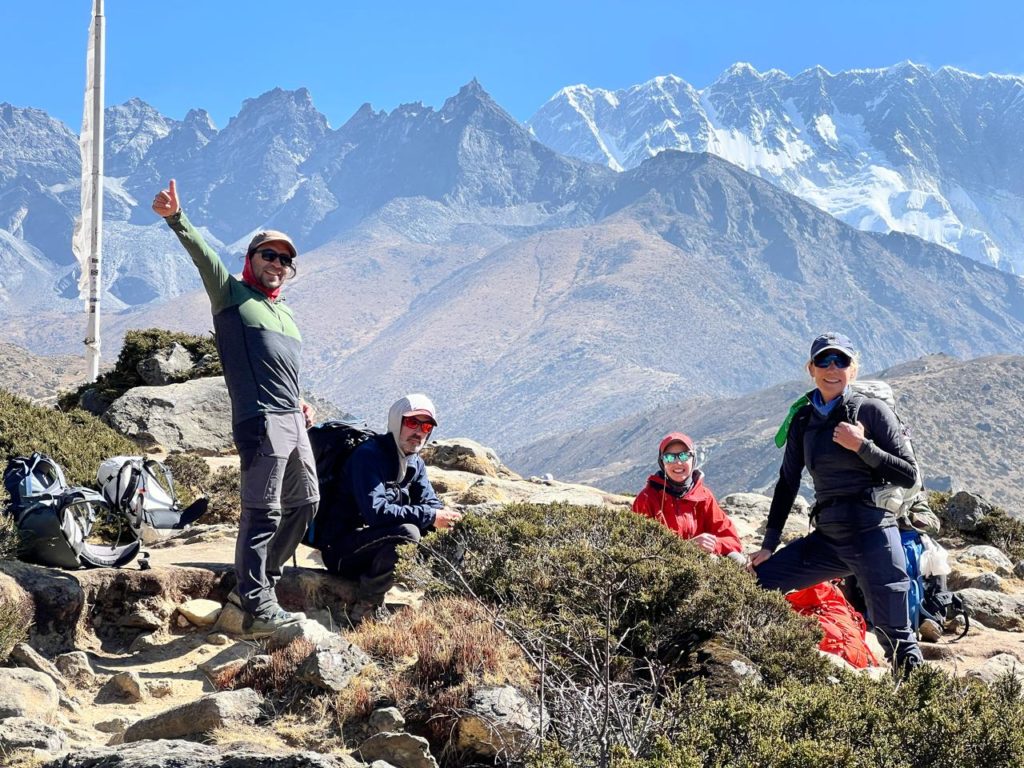
While we are preparing to say farewell to many of our climbers as they round out their trips, we welcome into Kathmandu our 30 Day Speed Ascender Jesse who arrived safely today. He is awaiting some delayed baggage but once that has caught up to him, he and Guide Tomi will heli up to Pheriche and move into Everest Base Camp.
Our Everest summit team have kept busy over the past few days keeping their acclimatization by doing hikes up Pumori and keeping skills current with lots of practice of ladder crossing, fixed line ascension and rapelling on the glacier by camp. They will now start preparing to head uphill on their first rotations now that the icefall route is fixed and open. A delayed start but not a big deal in the scheme of the expedition.
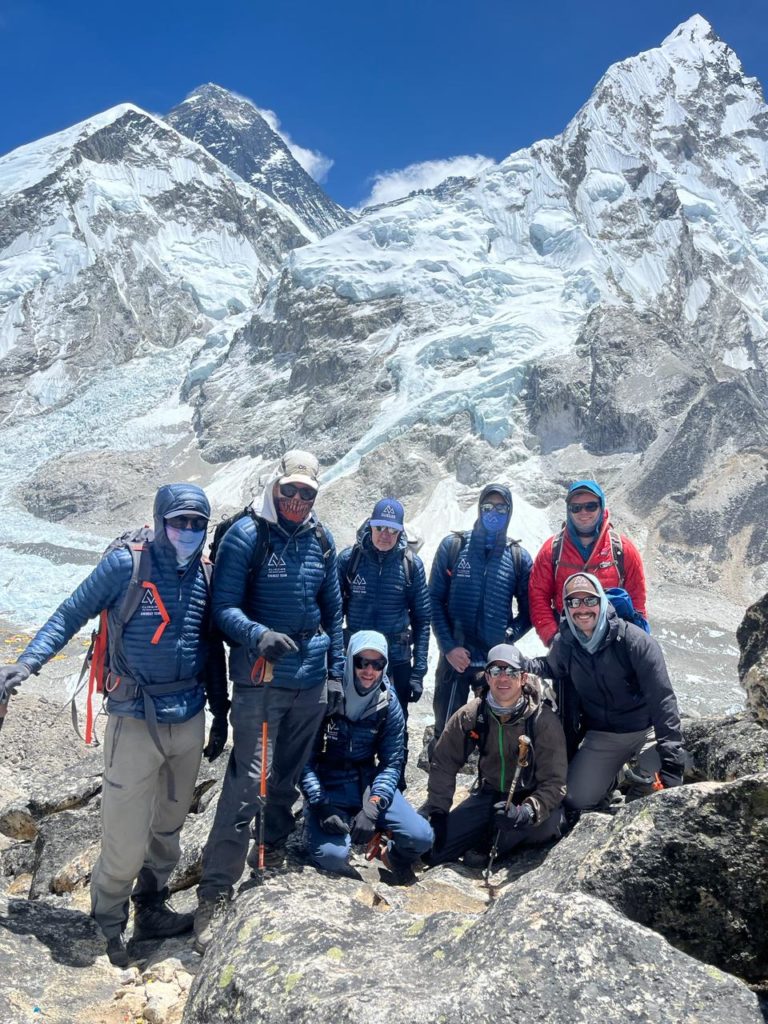


All is well in the Himalaya - we hope you have a great weekend.
Alpine Starts on Lobuche
Happy Friday! Here are the updates from our teams in the Khumbu Valley and at Everest Base Camp. We will be back on Monday with another update - stay tuned.
Our 40 Day Speed Ascent team will head to the summit of Lobuche tomorrow, kicking off with an alpine start in the wee hours of the morning. The route to the Lobuche summit has been challenging this year because of the low snowfall. These conditions present much more technical terrain. We wish the entire team all the best of luck!
Meanwhile, our Everest Base Camp trekkers have successfully returned to Lukla, rounding out their trek. Congratulations to all! There have been some weather delays in Lukla over the last few days, which has created a bit of a flight back up. Our team has elected to take a helicopter back to Kathmandu tomorrow, which will be a scenic treat!
 That's a wrap for our 2024 Everest Base Camp trek! (Photo Credit: Kat S.)
That's a wrap for our 2024 Everest Base Camp trek! (Photo Credit: Kat S.)
Our Lobuche climbers are tucked up in bed in Pheriche. Tomorrow, they will continue their trek down the Khumbu Valley to Namche.
Up at Everest Base Camp, our incredible Sherpa teams are ferry loads to Camp 1 and Camp 2 now that the route is open through the Khumbu Icefall. Once this is done, our summit climbers will begin their rotations! In the meantime, our summit climbers are happily training and hiking to keep active recovery.
The Khumbu Icefall is Open!
After a successful summit on Pokalde, our 3 Peaks team has reached Island Peak, the final climb of this expedition. Tomorrow, at 2 am local time, under the guidance of CTSS guide Tomi Ceppi, the team will start their summit bid of Island Peak (20,305 ft/6,189 m). Good luck to the entire team!
Here are a few shots of the 3 Peaks team on the summit of Pokalde.
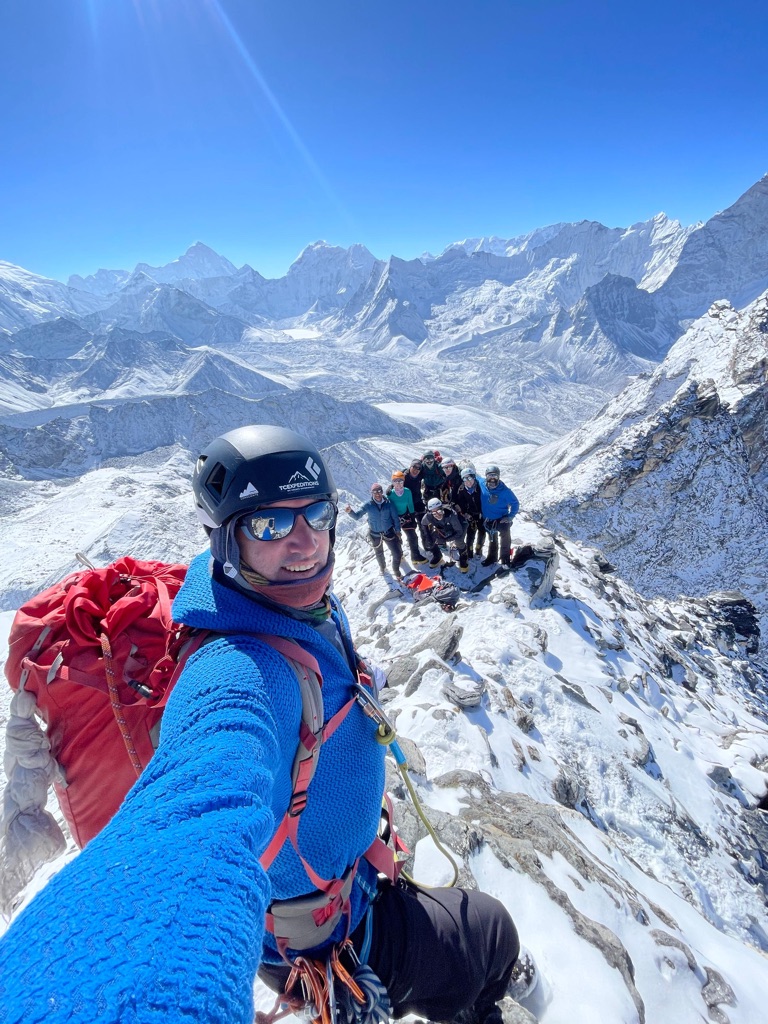 A summit selfie for Guide Tomi Ceppi and the 3 Peaks team!
A summit selfie for Guide Tomi Ceppi and the 3 Peaks team!
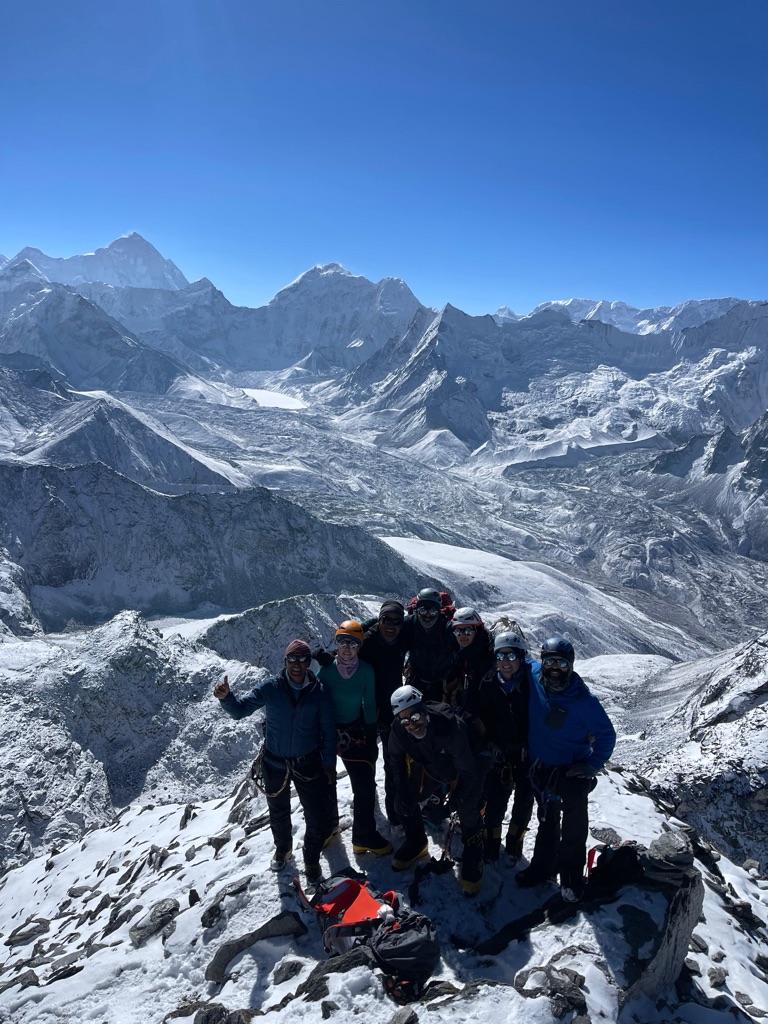 3 Peaks team on the summit of Pokalde (Photo Credit: Tomi C.)
3 Peaks team on the summit of Pokalde (Photo Credit: Tomi C.)
Big news came in from Everest Base Camp today. The route through the Khumnu Icefall to Camp 2 has been opened for the season! A big thank you to the incredible work of our Icefall Doctors:
- Ang Sarki Sherpa
- Dawa Nuru Sherpa
- Pemba Tshering Sherpa
- Ngima Tenzi Sherpa
- Ngawang Chimmi Sherpa
- Dawa Chirri Sherpa
- Dawa Jangbu Sherpa
- Mingma Gyaljen Sherpa
Now that the route has been opened to Camp 2, our Sherpa team will be able to start setting up camps on the upper mountain. Shortly after this, our first summit climbers will follow their route on their first rotation.
CTSS guide Josh McDowell reports that our Western Guided team had another full day of training in the lower Khumbu Glacier, and he shared that everyone is doing well. With their skills training under their belt, this team is now ready for their first rotation on Mount Everest.
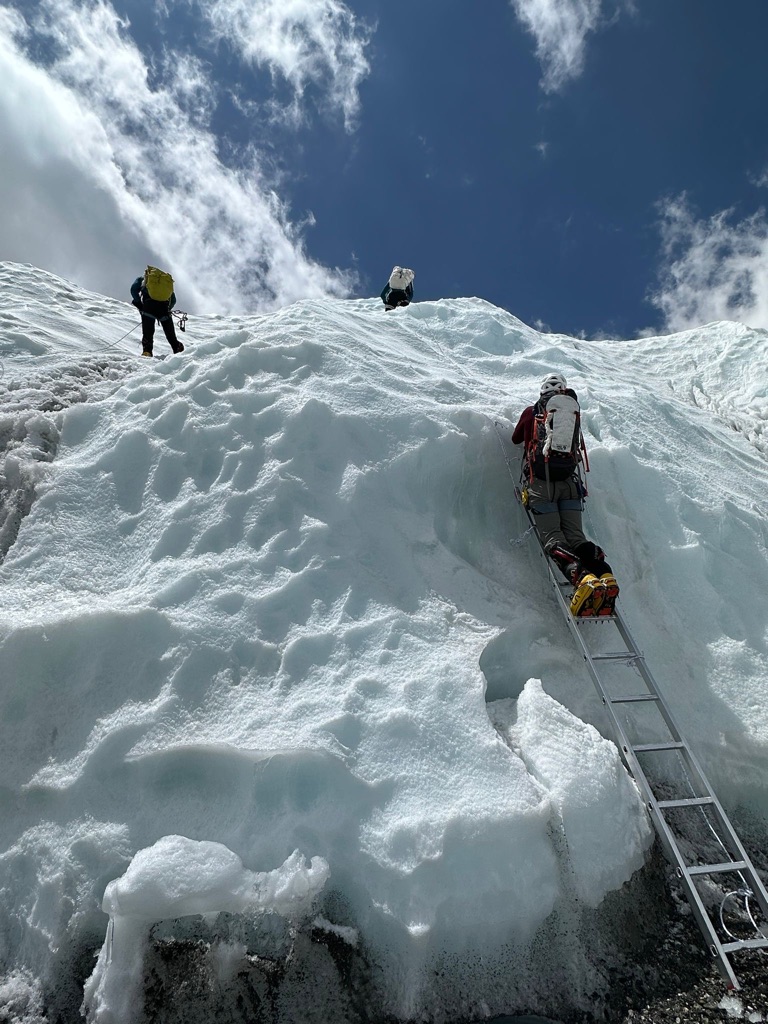 Skills training on the lower Khumbu Glacier for our Western Guided team. (Photo Credit: Josh McDowell)
Skills training on the lower Khumbu Glacier for our Western Guided team. (Photo Credit: Josh McDowell)
Our Everest Base Camp trekkers, who are trekking back down the Khumbu Valley, have arrived in Namche just in time to witness a Nepali wedding at Camp de Base! What a treat!
 CTSS guides Josh McDowell and Robert Jantzen at Everest Base Camp in our infamous Big House.
CTSS guides Josh McDowell and Robert Jantzen at Everest Base Camp in our infamous Big House.
A Puja Blessing for our Expedition
On April 16th, the CTSS Everest team, including guides, staff, climbers, and trekkers, enjoyed a Puja at Everest Base Camp. A Puja is a Tibetan Buddhist ritual or blessing ceremony part of Sherpa life. During this ceremony, a High Lama, who travels from afar will ask the mountain deity for safe passage for our team.
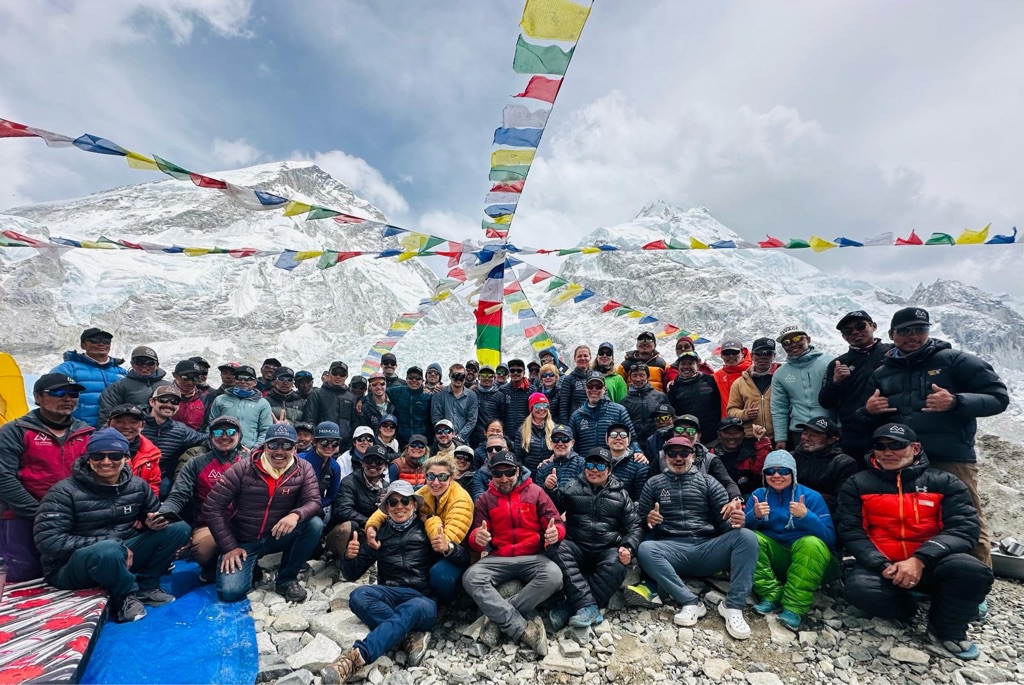 The CTSS Team at the Puja earlier this week. Photo Credit: Kat S.
The CTSS Team at the Puja earlier this week. Photo Credit: Kat S.
During the Puja, the Lama chants and blesses our expedition members, guides, staff, gear and equipment before our teams start climbing the upper sections of Mount Everest As you might expect with any celebration, there was plenty of good food and drink for all, including offerings for the mountain deity.
The Puja is always a chance for climbers, trekkers, and guides to socialize and celebrate with each other, Sherpa and non-Sherpa alike, and solidify our bonds before heading higher. The ceremony concludes with a traditional Sherpa dance, locking arms and forming a semi-circle before the Puja altar. The culmination of the ceremony is raising the Puja pole in the center of the altar and stringing prayer flags over our Base Camp, building a zone of protection for the team. When the flags blow in the wind, Sherpa believe they are sending out prayers. This is a sacred part of any Everest and Lhotse expedition, and the Sherpa, who draw no distinction between their daily lives and their Tibetan Bhuddist faith, appreciate and welcome us in this ritual.
Our Everest Base Camp trekkers enjoyed an ice climbing clinic on the Khumbu Glacier just outside Base Camp. They enjoyed learning new skills on the glacier and got a taste of what it would be like to be an Everest climber. After that, our trekkers who opted for a scenic helicopter return departed for Kathmandu and are now relaxing and celebrating at their hotel! The rest of the Everest Base Camp trekkers have begun their hike down the Khumbu Valley and are in Pheriche. Tomorrow, they will drop to Namche.
Our Gokyo Lakes Extension trekkers are excited for what’s to come. Tomorrow, they will stay at Lobuche before heading over Cho La Pass.
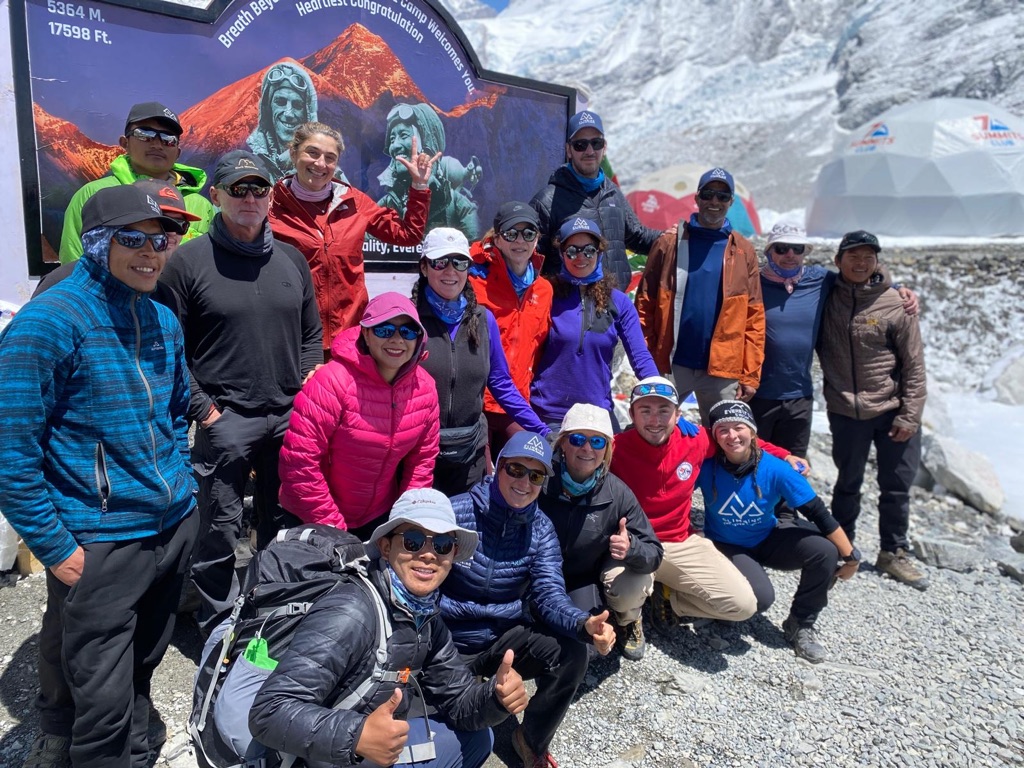 Everest Base Camp trekkers enjoyed their time at Everest Base Camp. The team has now split into three groups: scenic helicopter crew, trekking crew, and Gokoy Lakes Extension crew. Photo Credit: Kat S.
Everest Base Camp trekkers enjoyed their time at Everest Base Camp. The team has now split into three groups: scenic helicopter crew, trekking crew, and Gokoy Lakes Extension crew. Photo Credit: Kat S.
Our Everest summit climbers are training, doing drills, and honing their skills for what lies ahead. Guide Josh McDowell reports, “We had a really amazing day of training on the glacier today. Nani and I set up a great course for the crew, and everyone got a lot of quality reps. We are going to do another half day of training tomorrow.” The team is highly positive and makes excellent use of their time.
Western Guided Team just outside Everest Base Camp completes drills, including fixed line climbing, rappelling, and ladder crossings. Pics by Josh McDowell
 Team Drills: Rappelling
Team Drills: Rappelling
 Team Drills: Fixed Line Climbing
Team Drills: Fixed Line Climbing
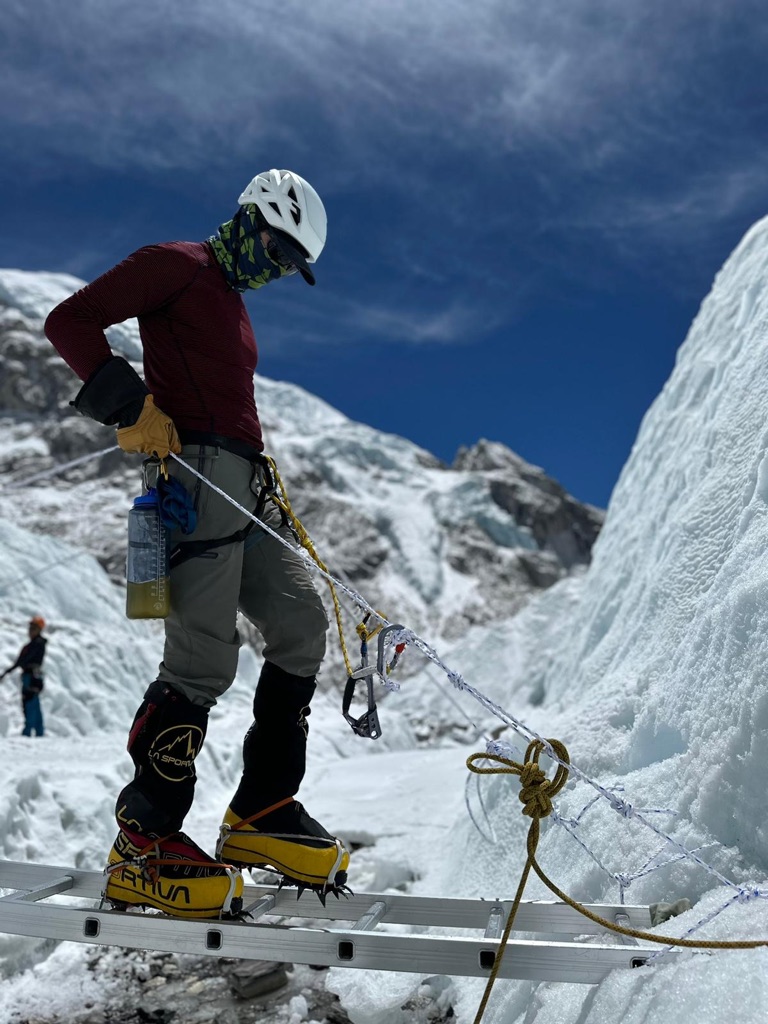 Team Drills: Ladder Crossings
Team Drills: Ladder Crossings
The Khumbu Icefall has been challenging this season. The icefall doctors are working hard to fix the route, which will allow access to the upper mountain for both climbing Sherpas to carry and climbers to begin their rotations.
Meanwhile, our Lobuche climbers, Private Camp 3 climber Andrea, with CTSS guide Robert, and our Personal Sherpa Everest climbers Aga, Lee, and Darragh arrived in good style this afternoon at Everest Base Camp. Guide Robert checked in with a short and sweet “Great set-up as usual! All is well.”
Our 3 Peaks team has been hard at work. They’ve summited their second peak, Pokalade (19,049 ft/5,806 m) on April 17th. They are in Chucking and are making great progress, toward their next objective – Island Peak.
Congratulations to the following climbers who summited Pokalade:
- Mr. Tim P.
- Mr. Scott Y.
- Mr. Faris R.
- Ms. Monika Z.
- Ms. Julia H.
- Ms. Vanessa N.
- CTSS Guide Tomi C.
Here are a few photos from guide Tomi C. of our 3 Peaks team on Pokalade earlier this week.



Our 40 Day Speed Ascent team is acclimatizing and doing skills training at Lobuche High Camp ahead of their summit push in the the coming days. After that, they will head to Everest Base Camp and fold in with the rest of the team at Base Camp.
That’s all from here, friends and family! We are excited to share more as our teams start rotations on Everest and get into position to take their summit bid.
Lobuche East to Everest Base Camp
Happy Monday! All of our climbers and trekkers were busy over the weekend. Here's a little recap of what's been happening in the Khumbu Valley.
As mentioned last week, our Western Guided team summited Lobuche on April 12th. CTSS guide Josh McDowell reported that the route was strenuous, but everyone did well, and the group's movement skills were sharp. Congratulations to:
- Mr. Bert Snarr
- Mr. Michael Fortune
- Mr. David Keating
- Mr. Terry Ledgard
- Mr. Jared Harris
- Mr. Josh McDowell (Guide)
- Mr. Nani Stahringer (Guide)
The evolution of a summit through the eyes of our Western Guided team. Thank you to CTSS guide Nani S. for sharing these photos from their summit of Lobuche:
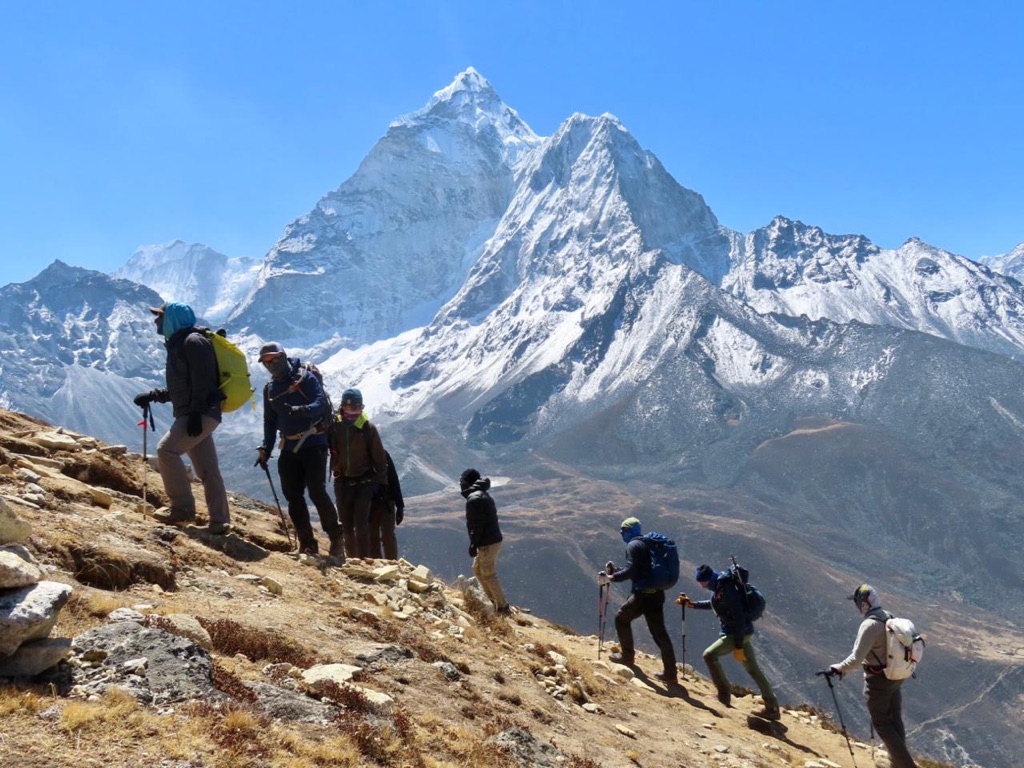 Trekking Up
Trekking Up
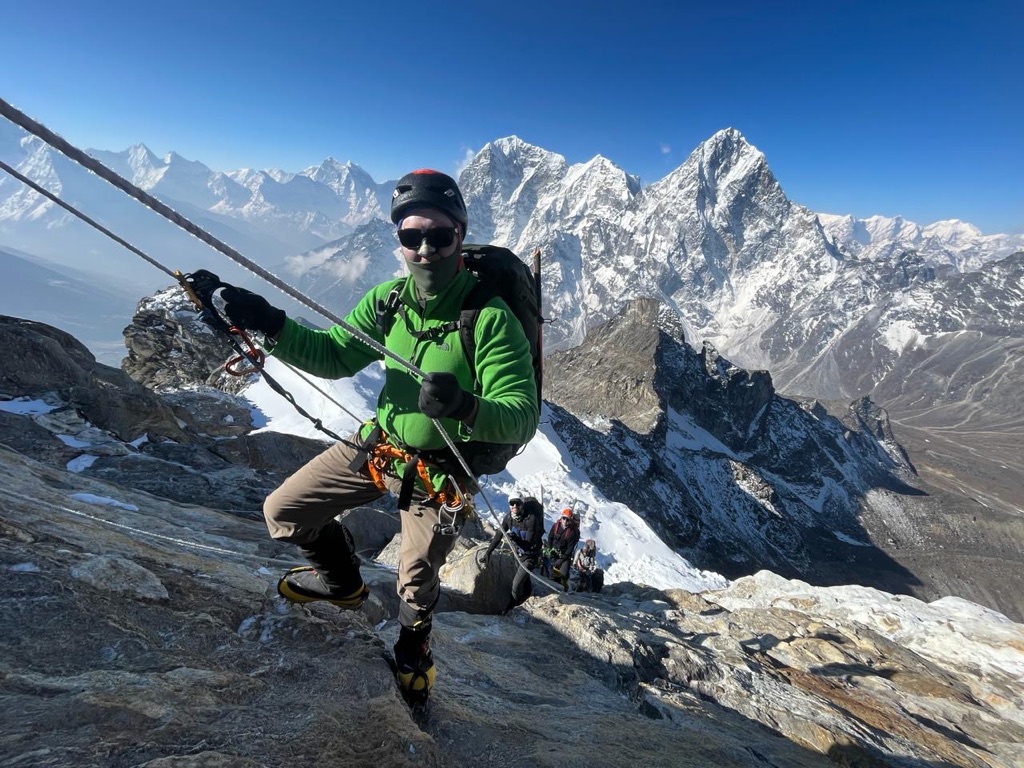 Roped Up
Roped Up
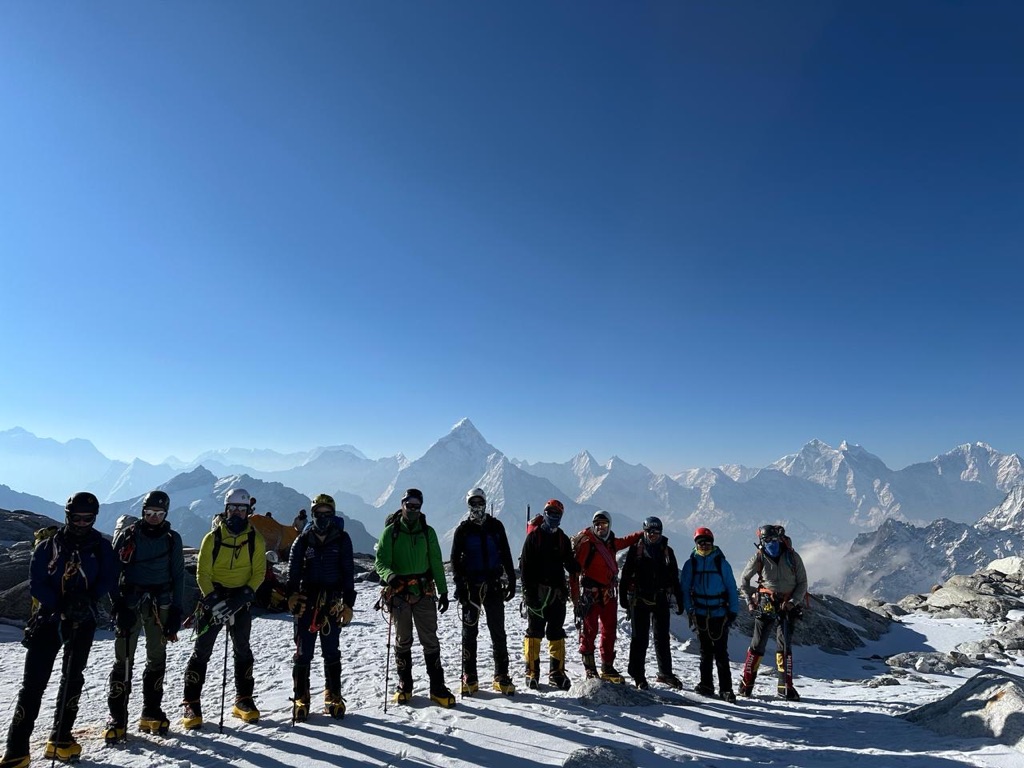 Getting Closer to Lobuche
Getting Closer to Lobuche
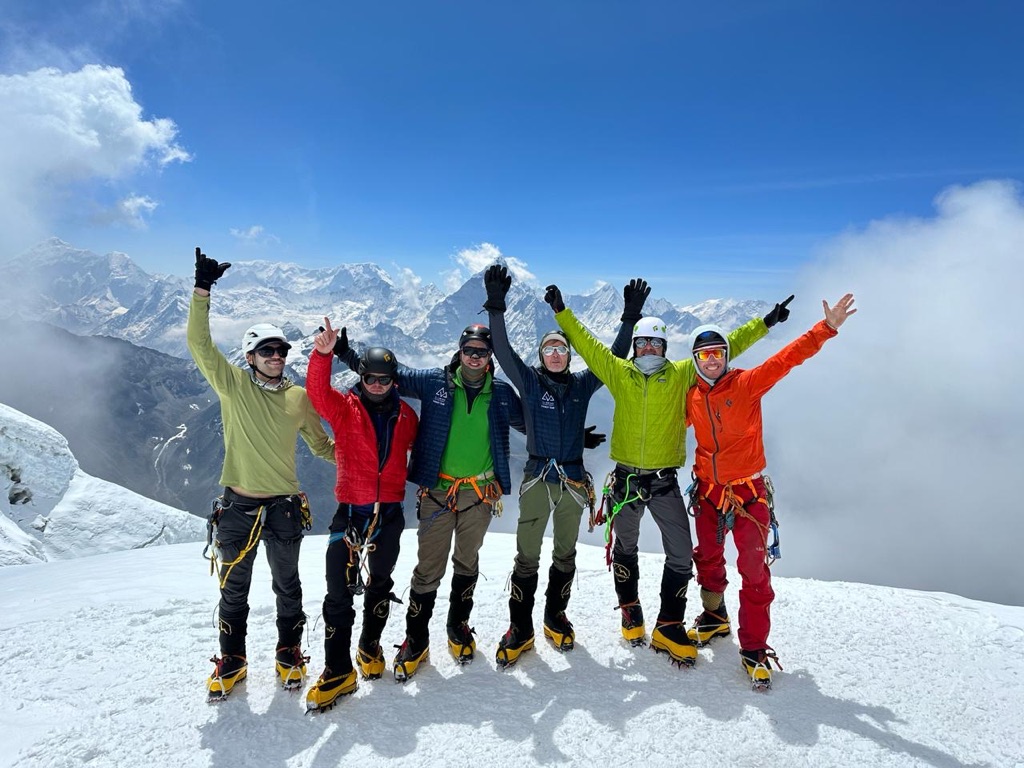 Hello, Lobuche Summit!
Hello, Lobuche Summit!
Since then, our 3 Peaks and Western Guided teams have arrived and settled into Everest Base Camp for the season. Here's the note that CTSS guide Josh McDowell shared:
"We rolled into EBC, and everyone is stoked to be here. We are all super impressed with the CTSS camp, and everyone is enjoying some well-deserved downtime today. Showers and connectivity are on the schedule for the day."
While our Western Guided team gets the hang of camp life, our 3 Peaks team won't be in for long. They are headed out soon to climb their last two peaks, Pokalade (19,049 ft/5,806 m) and Island Peak (20,305 ft/6,189 m).
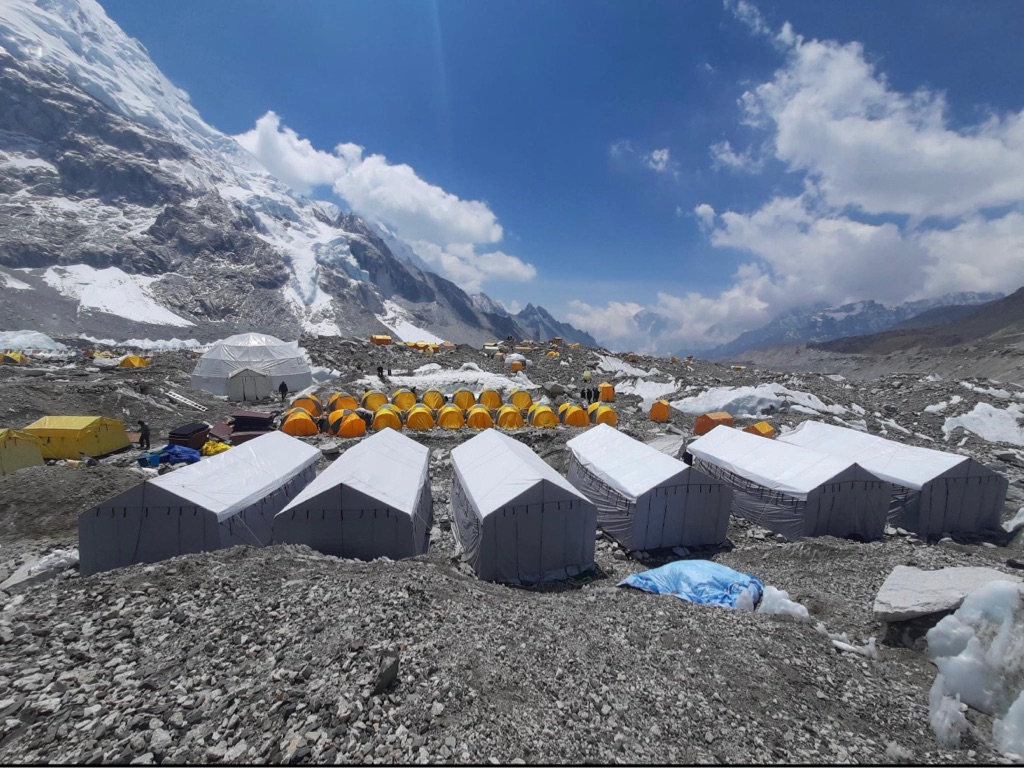 A bird's-eye view of CTSS Everest Base Camp with our famous Big House in the middle of camp!
A bird's-eye view of CTSS Everest Base Camp with our famous Big House in the middle of camp!
 All smiles from Everest Base Camp for our climbers, trekkers, guides, and support teams!
All smiles from Everest Base Camp for our climbers, trekkers, guides, and support teams!
On April 13th, our 1:1 Private climbers summited Lobuche. Congratulations to the following climbers:
- Mr. Marc Baumgartner with Guide Naren
- Ms. CJ Baumgartner with Guide Naren
- Mr. Aseem Chawla with Guide Ashish
- Ms. Susan Agar with Guide Pega
- Mr. Randall Ebersole with Guide Dorjee
- Mr. Chen (Blake) Li with Guide Abiral
- Ms. Riki Jones with Guide Lhakpa
- Ms. Pascale Soubrane with Guide Astani
- Mr. Christopher Bramwell with Guide Dawa
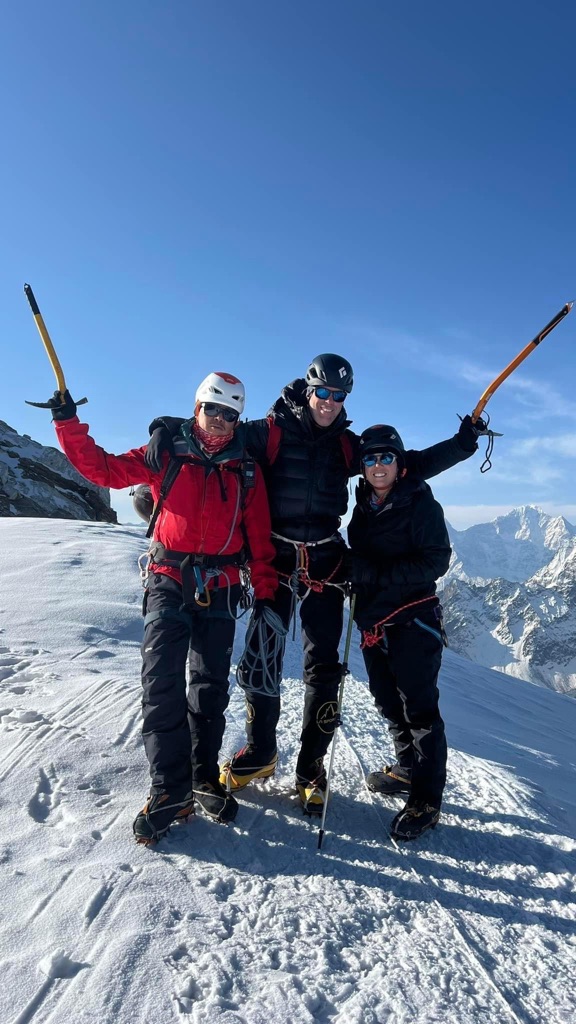 Marc B & CJ on top of Lobuche with Guide Naren.
Marc B & CJ on top of Lobuche with Guide Naren.
A few photos from our Lobuche climbers and Everest Base Camp trekkers who were at Lobuche Base Camp this weekend. Thanks to CTSS guide Kat S. for sharing these photos.
 Everest Base Camp trekkers and Lobuche climbers are feeling strong in the Khumbu Valley!
Everest Base Camp trekkers and Lobuche climbers are feeling strong in the Khumbu Valley!
 The world's highest bakery? Yes, please!
The world's highest bakery? Yes, please!
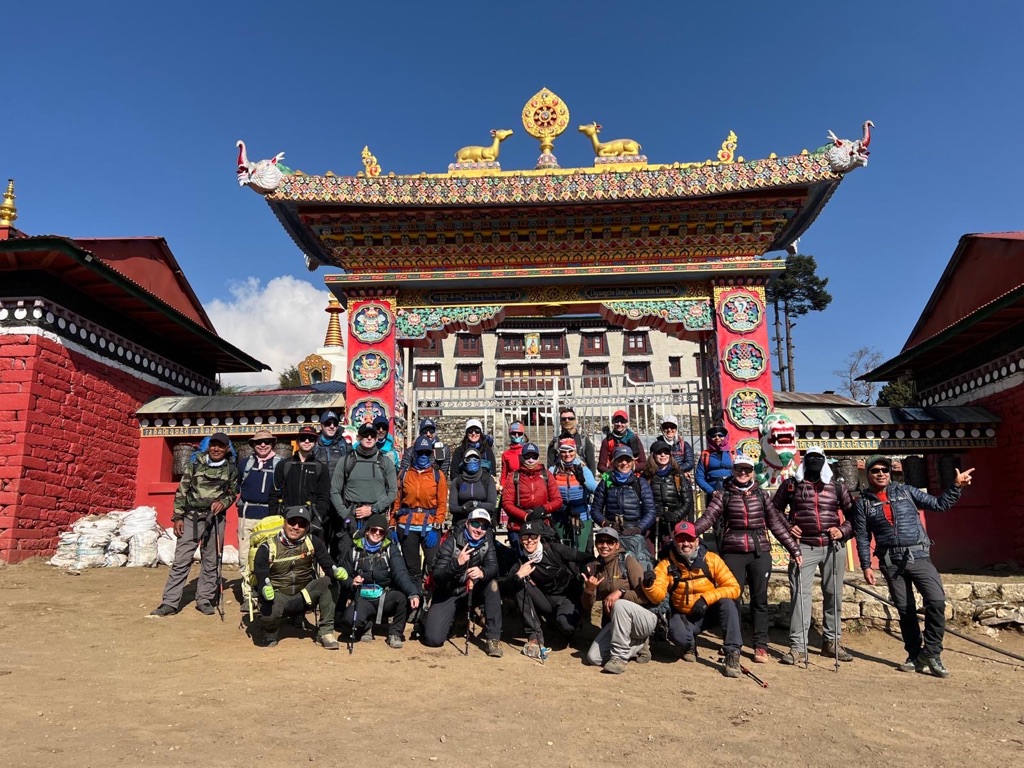 One of our favorite stops along the trek to Everest Base Camp is the Tengboche Monastery. Our Everest Base Camp trekkers and Lobuche climbers visited last week.
One of our favorite stops along the trek to Everest Base Camp is the Tengboche Monastery. Our Everest Base Camp trekkers and Lobuche climbers visited last week.
A new wave of climbers arrived (and departed) Kathmandu. On April 14th, we welcomed the 40-Day Speed Ascent team to Nepal. After gear checks and guide briefings, the team took a helicopter to Pheriche. The team is excited to have their expedition underway, and they will soon join the rest of the climbers at Lobuche and Everest Base Camp.
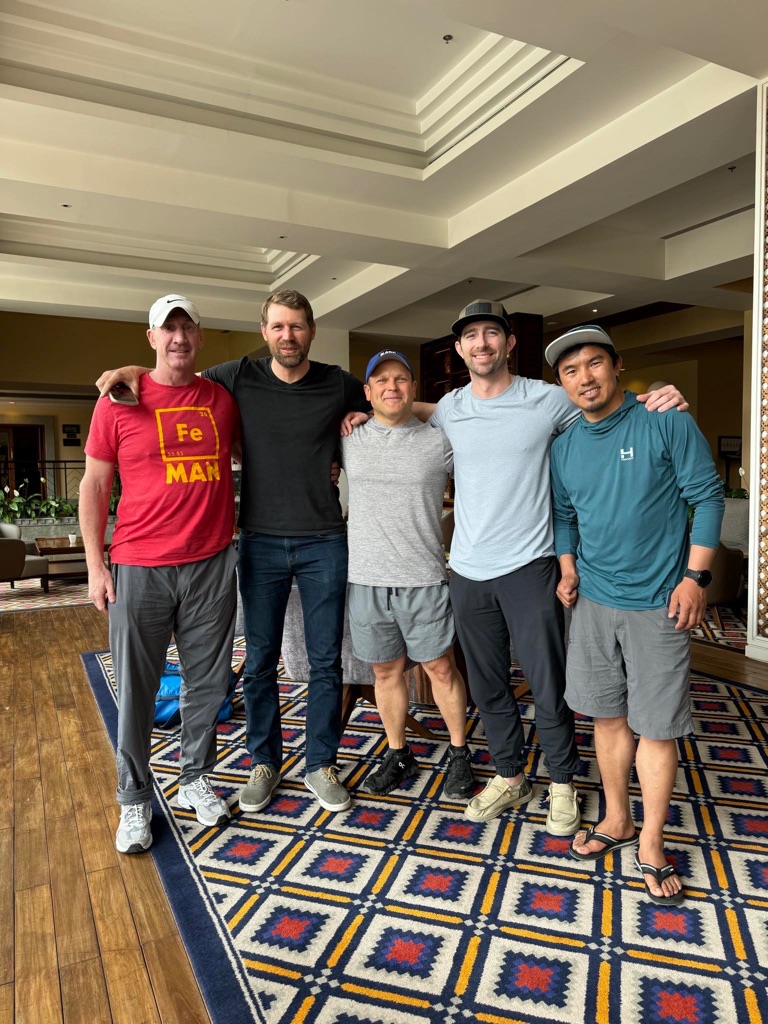 Our 40-Day Speed Ascent Team with Guide Pasang and Expedition Leader Mike Hamill in Kathmandu
Our 40-Day Speed Ascent Team with Guide Pasang and Expedition Leader Mike Hamill in Kathmandu
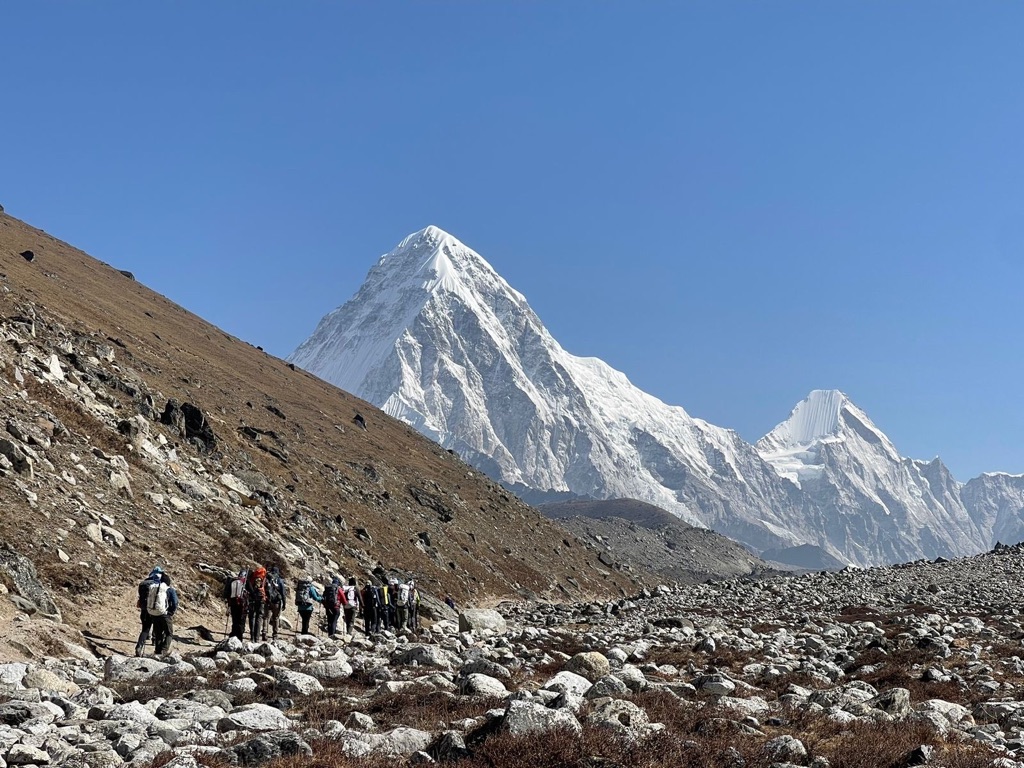 Pumori (23,494 ft/7,161 m) rises up along the Tibet-Nepal border and lies just 5 miles west of Mount Everest. (Photo Credit Tomi Ceppi)
Pumori (23,494 ft/7,161 m) rises up along the Tibet-Nepal border and lies just 5 miles west of Mount Everest. (Photo Credit Tomi Ceppi)
Vinson Advice from Mike Hamill
Personal advice on climbing Aconcagua from Mike Hamill

Mount Vinson is absolutely my favorite of the Seven Summits. Nestled deep in Antarctica, ascending one of the most isolated mountains on our planet is an unparalleled and exclusive privilege. Few climbers have the opportunity to climb this peak, and Vinson has far fewer summits than Mt Everest.
The journey to the mountain alone is an adventure. Accessible only for a brief period each year, the anticipation builds as we gather at the southernmost tip of South America before boarding another flight over the Southern Seas to Antarctica, touching down in the interior on a runway of blue ice. From there, we hop onto specialized ski planes to Vinson Base Camp.
After arriving at Vinson Base Camp, we’re ready for the climb. It’s a special feeling watching the small ski plane depart, leaving you and your team alone with the mountain. The humility and thrill of being as remote from civilization as possible—and the climb has yet to begin!
Here are a few things I’d like to offer up as some advice when you are heading to Vinson:
- Don’t underestimate the cold. Removing your face covering or a glove can lead to a cold injury. Listen closely to your guides and copy what they do to take care of themselves. Stay disciplined in keeping covered up to prevent frostnip or frostbite..
- Invest in the right gear. Having the right gear is critical. Polar temperatures are serious, and you need to closely follow our gear guides sent prior to your trip to make sure you’re prepared. Make sure you adhere to specific warmth ratings. Don’t try to cut corners, or “make do” with old systems/gear. On Vinson, make sure you protect yourself with the right clothing, climbing boots, sleeping bag, etc.
- Training for Vinson. Moving from Base Camp to Low Camp, we often use sleds pulled behind us to spread our pack weight and move more gear and equipment up the mountain. One of the most valuable ways to train for Vinson is by dragging a large car tire connected to your harness while wearing a weighted pack. It will train your body to pull and strengthen all the small stabilizer muscles you otherwise wouldn’t work in the gym. You don’t want your muscles to be sore on Day 1 of the climb.
- Manage expectations. Make sure your work and family understand the trip length and lack of communication. It is rare, but lengthy delays do happen without access to a cell or internet connection. The planes on the ice won’t fly in anything other than perfect conditions, so if you get a storm or poor visibility, you could be sitting at Base Camp for days on end. Bring a Kindle with preloaded books, and download some good podcasts or movies to your phone and a small portable solar system like a Goal Zero to recharge your device batteries.
- Expect to feel more physically taxed on Vinson. The relentless cold, the confusion that 24-hour daylight has on your body clock, and most importantly, the way the atmospheric pressure in Antarctica affects altitude perception. At the North and South Poles, the atmosphere has relatively low pressure compared to sea level, so it will feel higher, and you will feel more fatigued than on other mountains of similar altitude.
- Research Antarctica. Before you arrive, dive into the rich exploration history of this icy continent. It will intensify the experience as you imagine what the early explorers faced compared to our comfy base camp and present-day gear and equipment.
I’ve always found Vinson one of the most thrilling and life-changing of the Seven Summits, and I’m sure you will, too.
The explorers, adventurers, and mountaineers you meet in the heart of Antarctica are some of the most humbling, high-achieving, and fascinating people on Earth. Having the opportunity to connect with them and call them friends will be one of the most life-changing elements of your expedition.
Best Wishes,
Mike
Vinson Training & Prerequisites
Experience Level
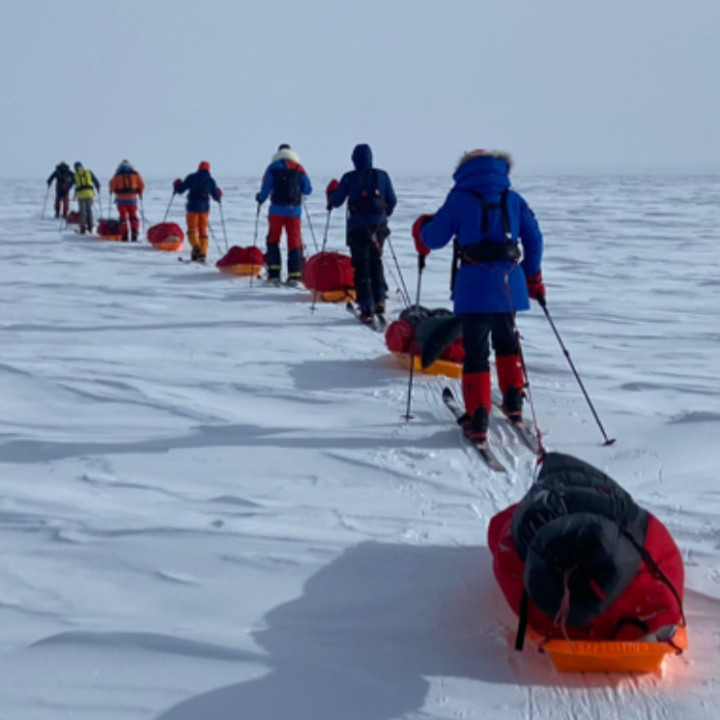
Vinson is a serious undertaking meant for climbers with prior experience in the cold and some climbing skills. Guides will work with clients throughout the expedition to provide safety, advice, logistics, technical guidance, and information to best ensure the clients’ summit success.
Physical Training
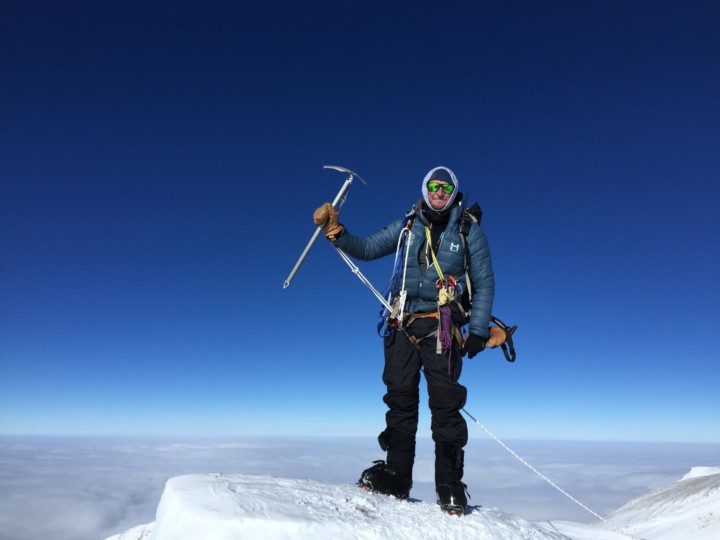
Your climb begins long before you reach the ice. We encourage you to incorporate training into your daily routine at least six months before the departure date. As your climb rolls around, you want to be in top physical and mental condition. Being fit at home is different from being strong at high altitudes and in extreme conditions.
Mindset

Mindset and mental preparation are integral to your success on any peak.
You should be prepared to:
- Be away from home/work for the duration of your climb
- Have a desire for rugged adventure travel
- Be open to receiving and deferring to guidance, support, and advice from your guides/expedition leaders even if you are an experienced mountaineer
- Be comfortable having open conversations with your guides
- Be able to work well in a team environment by being supportive and respectful of fellow teammates
- Be humble, respectful, and considerate even under pressure
Vinson Expedition Beta & Route
Elevation: 16,050 feet
Duration: 16 days
Difficulty: Advanced
Route: Branscomb Shoulder Route
Continent: South America and Antarctica

Route Choice
We have chosen the Branscomb Shoulder route on Vinson for the best chances of summit success. This route is located on the southern side of Mount Vinson and begins at Vinson Base Camp. This route is often dubbed the standard route as it is a more moderate option to the summit of Vinson, but it still presents significant challenges, including crevasses, icefalls, and harsh weather conditions.
The route is named after the Branscomb Glacier, which flows along the southern slopes of Mount Vinson. The “shoulder” refers to a feature on the mountain where the route traverses, leading climbers towards the summit.
The Branscomb Shoulder route consists of low-angle glacier walking at lower elevations with some moderately steep fixed-rope and ridge walking as the elevation increases. Overall, the climbing is incredibly enjoyable, albeit cold, and very doable. Taking advantage of the endless daylight, we’ll climb when conditions are best, working up through Low Camp to High Camp in preparation for our summit bid.
How to Choose The Right Vinson Expedition
How to Choose The Right Vinson Expedition
Share Expedition
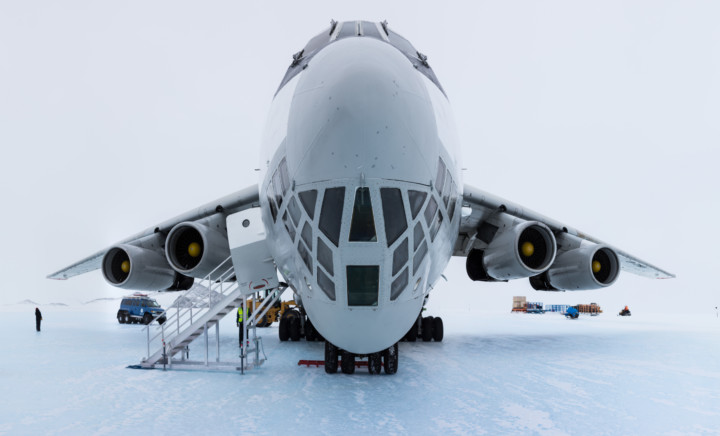
It is important to research and choose the right expedition company to support you, help guide you through all logistics, and be there for you on the mountain. You want to do your homework so you feel 100% confident in your choice and can focus on the climb.
We encourage you to look closely at both the big picture and the small details. Consider a company’s priority on safety, the quality and experience of its guides, its reputation, and its level of “care factor.”
Safety & Success
Your safety and success are the top priorities, in that order.
A climbing company should invest heavily and plan extensively for your safety.
Climbing the Seven Summits is committed to providing the highest-quality expeditions on Vinson Massif. You can be assured that it will be both challenging and fun, a true once-in-a-lifetime experience. As always, our professional priorities are safety and success, which we achieve by outfitting our teams with the best logistics and the most capable, qualified, and seasoned guides in the world.
CTSS is pleased to boast a 100% expedition success rate on our Vinson expeditions. Who you choose as the outfitter of your Vinson expedition will be one of the most important decisions you’ll make. Sound leadership is the difference between a great expedition and a miserable experience.
Leadership
This expedition will be organized by Mike Hamill, Owner of Climbing the Seven Summits. Mike has personally guided nearly 20 Vinson expeditions, 11 Mount Everest expeditions, 24 X 8,000m expeditions, 6 Mount Everest summits, currently holds the record for most non-Sherpa summits of Cho Oyu, and has written the guidebook to “Climbing the Seven Summits,” making him one of the most experienced guides on the mountain. More than 100 summits have been notched on Vinson under Mike’s direct leadership. Climbing the Seven Summits expeditions are meticulously organized with the best logistics.
We feel that our guides are incredibly important to our success. CTSS employs only world-class leaders who are known for their focus on client care and experience.
Vinson is a serious undertaking meant for climbers with prior experience in the cold and some climbing skills. Guides will work with clients throughout the expedition to provide safety, advice, logistics, technical guidance, and information to best ensure the clients’ summit success.
Values & Philosophy
This is sometimes a little harder to identify as it’s more a feeling than a sales pitch, but you should get a feel for a company through their little interactions, their care factor, their attention to detail, their corporate social responsibility, their responses to you.
Mountaineering can be high-risk and stressful, so pick an operator who has strong core values and a team mentality that aligns with yours. When things get challenging, you can rely on open lines of communication, knowing they will do what they can to support you.
It is this team cohesiveness that flows through to each individual climber and helps them stand on top.
Vinson Travel Guide
Expedition Meets in: Punta Arenas, Chile
Continents: South America and Antarctica
Currency: Chilean peso in Chile and US dollar in Antarctica
Population: 124,169 (Punta Arenas, Chile) and 1,000 – 4,000 (Antarctica)
Official Language: Spanish in Punta Arenas, Chile, and no official language in Antarctica, but English, Spanish, and Russian are among the most commonly spoken languages at the research stations.
Seasons to Climb: During the Antarctic summer you can take advantage of the warmer climbing temperatures and reduce the risk of frostbite.
Getting There & Meeting Location:
Getting to Punta Arenas, Chile, is relatively straightforward, with several airlines offering flights to and from the city each day. Due to its southerly latitude, most climbers will have more than 12 hours of flights to reach Punta Arenas. Please pay close attention to your flight times, layovers, and leave date. In the days leading up to your flight, double-check that your flight has not been canceled or changed.
Most flights to Punta Arenas connect through Santiago. Remember to collect your checked luggage BEFORE clearing customs. You will then need to re-check your bags for your domestic flight to Punta Arenas at the domestic terminal. If your luggage does not arrive, please complete a missing form/claim for lost luggage BEFORE leaving the Santiago airport.
The first day of your itinerary is an arrival day, meaning you can book your flights to arrive in Punta Arenas at any time on that first day. We strongly recommend arriving a day in advance, if possible (the day before the arrival day), or at the very least in the morning or early afternoon of Day 1.
Possible flight and luggage delays are two of the reasons we have scheduled a few buffer and prep days in Punta Arenas, as the Antarctic flight service will not hold flights onto the ice for delayed passengers, luggage, or any other reason.
We’ve built in a planning day after everyone arrives in Punta Arenas on Day 2. The whole team will meet this day, usually at breakfast, to make introductions, have our team briefing, and answer any questions.
Upon arrival in Punta Arenas, it is easy and affordable to grab a taxi to your hotel. CTSS will email you prior to the climb with updated hotel information to make sure you get to the right spot. Check in at the front desk and let your guide know you made it. Relax and unwind, knowing that you have no formal activities today. Your guide may be out buying and packing food but will check in with you as soon as possible upon returning to the hotel.
Punta Arenas, Chile International Airport
- Presidente Carlos Ibáñez del Campo International Airport (PUQ)
Expedition Transportation:
Your flights in Punta Arenas, Chile to and from Union Glacier, Antarctica, and Vinson Base Camp are included in your expedition.
Accommodation:
Your expedition includes all of your accommodations, as noted in the inclusions and exclusions.
Money:
It is better to have more money than you need than not enough. Most things are covered on the trip once you land in Chile. You can review the inclusions and exclusions list for more details. Once you land in Punta Arenas, Chile, you can exchange your money for Chilean pesos to use while you are in Punta Arenas. While in Antarctica, you can use US dollars.
Tipping:
Tipping is customary while you are in Chile. Tipping taxi drivers is not expected, but rounding up is appreciated. A tip of 1,000 pesos per night per person is considered a good tip for housekeeping, and a little tip per bag is expected for bellhops. Guide tips, although not required, are always appreciated by our dedicated guide staff.
Language:
Chile’s official language is Spanish. While in Punta Arenas, you should expect difficulty finding English-speaking shopkeepers or the general public. Most hotel front desk employees will have some command of English, and our logistics staff speak English well.
The common language in Union Glacier, Antarctica, is English.
Cell Phone Coverage:
Chile Country Code: +56
While you may find cell coverage in Punta Arenas, Chile, please check with your provider about roaming or international charges. Wi-fi calling from hotels in Punta Arenas is also an option.
There is no cell phone coverage in Antarctica. All communications must be done via satellite phone or text on the Iridium satellite network. CTSS will have a satellite phone that can be made available to clients at $3 per minute on a very limited basis. Please don’t count on having frequent access to the satellite phone, as we want to conserve battery power in case of an emergency. Please prepare your friends and family at home to be out of communication and to rely on the blog/CTSS for updates. Remember that no news is good news. Family and friends need to understand that the blog may not get updated every day and that the lack of updates does not indicate any problems.
Local Emergency Contacts:
In Chile, you can reach emergency services by dialing:
Ambulance: 131
Fire: 132
Police: 132
International Arrivals & Visas:
If you are transferring through Santiago, Chile, you will need to clear customs there, claim your bags at the international terminal, and recheck them at the domestic terminal. Upon exiting the plane, walk to the customs area and have your passport and visa form handy. This process can take some time, so make sure you have at least three hours between flights. It can take up to an hour to clear customs, depending on the number of flights landing. If it is your first time in Chile, you may be required to buy a visa upon arrival at a desk just before getting into the customs line, depending on which country you are from. Double-check if this is required of you before waiting in line.
You should keep a copy of your embassy or consulate information with you while traveling through Chile. For US citizens this information is:
US Embassy Santiago
Av. Andrés Bello 2800
Las Condes, Santiago, Chile
Phone: +56 (2) 2330-3000
https://cl.usembassy.gov
SantiagoUSA@state.gov
Electrical – Punta Arenas:
Chile’s grid operates at 220 volts and 50 hertz utilizing Type C and Type L plug styles. Note that Type C sockets also work with Type E and F plug styles, while Type L sockets also work with Type C plugs. Review your electronics and bring any necessary adapters with you.
Electrical – Antarctica:
While CTSS cannot guarantee access to electrical plug-ins while at Union Glacier camp they are often available to charge basic electronics or battery packs. The grid at Union Glacier runs the same as the U.S. grid, operating at 120 volts AC power with North American Type A and B plugs.
Potable Water:
It is recommended to opt for bottled water or treat your own tap water while traveling in Chile. We will provide snow melt while on our climb/ski but will not boil the water prior to filling water bottles to save fuel and time. Please bring water purification for your personal water bottles. In established Antarctic field stations, the provided water is potable.
